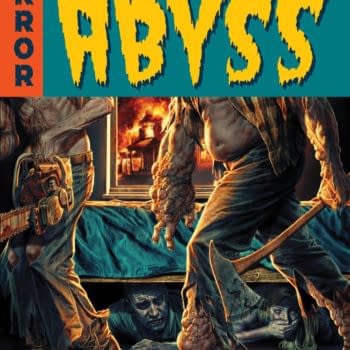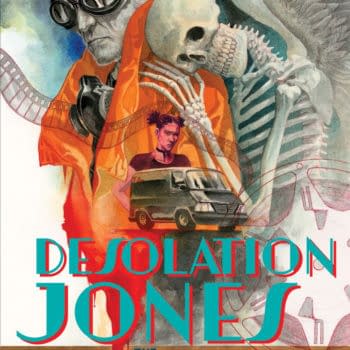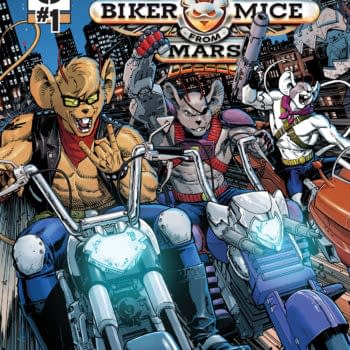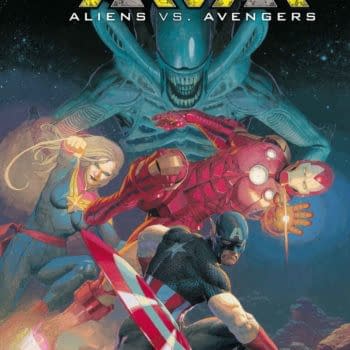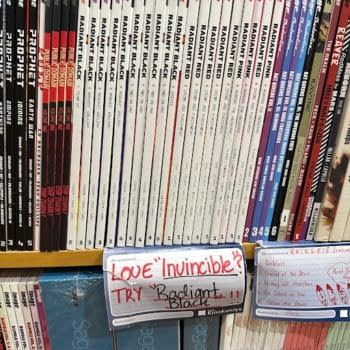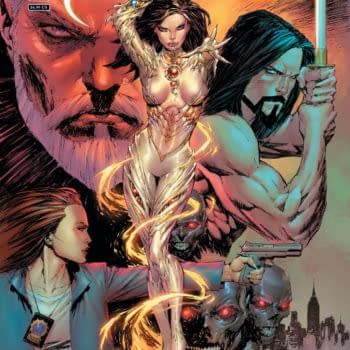Posted in: Comics | Tagged: Comics, entertainment
Dean Haspiel's Harvey Awards Keynote Speech On Saying Goodbye To Hang Dai

I also got the chance to hang out with him and the rest of Hang Dai Studios last year, one of the more pleasant comic community experiences I've enjoyed.
At this year's Harvey Awards at Baltimore Comic Con, he gave the keynote address. It was pretty much everything we wanted from Dean. He posted the full text to his Tumblr page and gave Bleeding Cool permission to reproduce it, below.
When Marc Nathan called me on the phone a few weeks ago, he asked if I was sitting down. I was. So, I stood up. Marc then asked me if I would like to be the keynote speaker at the Harvey Awards. I sat right back down. I told him I appreciated his offer and was honored that he asked me but I had to decline. It was too nerve wracking to even consider such an honor. He asked me to think about it for a day.
See, Marc was aware of a recent rant I made about my current status as a freelance artist trying to make ends meet in my native NYC. A rising epidemic that most of us can relate to as mutual comix makers and movers and shakers struggling to keep the lights on, no matter where we live. I think Marc wanted me to talk a little bit about that.
I'm currently wrapping up the first season of a free weekly webcomic I produce called The Red Hook for LINE Webtoons.com. It's a superhero story that's partially about a sentient Brooklyn whose heart gets broken by an indifferent yet entitled society. Brooklyn decides to literally and physically secede from New York to go back to days of old where society bartered their skills and talents for food and services and communities had each others back. A New Brooklyn is born where a sketch can get you a drink and a painting can buy you a house.
Christopher Calloway of Word of the Nerd interviewed me about my project and asked: "Brooklyn having a broken heart and becoming an island unto itself is an analogy for it undergoing a cultural change. Artists are losing their studios as the neighborhood becomes more "gentrified". How are you and your fellow artists living in the area coping with the change?"
Here's a version of my answer:
Our family is breaking up. As independent freelancers, there is nothing we can do. What was once $25 per square foot a few years ago has become $45 per square foot – if we're lucky. Most of us are moving back into our one-bedroom apartments. Communities and studios are dissolving. Anxieties are high and spirits are low. There's chatter of some freelancers making an exodus to the mountains or to affordable states but nothing organized.
I'm emotionally tethered by the fact that I'm a native New Yorker and it's the only place I've ever lived in. When some people think about NYC they think of the Empire State Building, Times Square, and Broadway theater. When I think about NYC, I think about the outliers who fuel the heart and energize the soul of NYC. But, as evidenced by abnormal rent hikes, land developers don't care about grass-roots culture. NYC is no longer interested in underwriting the avant-garde with affordable spaces.
I was having lunch with my friend and sometimes collaborator/writer/television producer, Jonathan Ames, and he agreed that art in NYC was compromised more than ever before. The wild stuff he performed and curated years ago at now defunct basements and second floor venues would be tough to engender today because who goes anywhere anymore when everyone is glued to their smart phone and tablet? It's hard to compete with an audience that can't extricate themselves from the internet for a couple of hours to experience something live and direct with carbon dioxide. Our surveillance society has created attention-deficit disorder zombies. The "scene" got taken hostage by the screen.
I grew up during a time when artists could live most anywhere in the city and I counted on the fact that there were going to be places for me to lay down my head so I, too, could take art seriously. My mother was deputy director of The NY State Council of the Arts for 30-years. Through her, I got to witness diverse artists, performers, and organizers of all measures do what they did and get by. It was that kind of leeway that encouraged me to sacrifice a normal life for the risk of a freelance one so as to create cool and exciting new ideas with like-minded artists, necessary to the growth and strength of our culture. What used to be less-than-desirable neighborhoods where artists could find a cheap spot to experiment and squeak by, hardly exists anymore. We made scary places cool enough to price us out.
For the first time in my life I'm thinking about leaving NYC but I'm having a mental block in taking that leap of faith. Maybe I should look into the food truck model? I could become a roving cartoonist on Route 66, performing my stories and selling my comix though a concession window. The price of gas might be cheaper than an old, windowless warehouse room stacked between a garbage dump and daily drug busts.
My rant got some attention from fellow artists across the nation and across our industry. But, you can easily replace their plight with most cartoonists who have dedicated twenty-to-fifty years or more of their life and service to help evolve our industry and perpetuate franchise characters, only to lose work because they didn't trend anymore in a business that doesn't provide a proper pension. I get that there is no guarantee in comix but, in the eternal words of Chris Oarr, "Give a crippled crab a crutch."
Come September 30th, at the end of this month, after many years sitting in the same room inches from my peers, creating comix and art under the banner of Hang Dai Studios, we will say our goodbyes. Some of us are going back home to start new lives while others are sparking new studios…smaller studios in more expensive spaces, far away. I'm giving myself a year to see how it all shakes out.
But, why?
I'm 49-years old and I still feel the same tingle I felt when I was a skinny little boy every week new comics come out. I remember getting a 50-cent weekly allowance from my parents and waiting at the newsstand on my corner for the clerk to rack the new comic books so I could be the first kid on my block to see what came out. To ogle the new covers and spy the new stories. Very quickly, 50-cents wasn't enough money to buy what I wanted. Especially when they raised the price from 20-cents to 25-cents! Soon, my parents stopped giving me an allowance when they saw what I spent it on and just bought me the comics I wanted until I discovered a holy grail.
West Side Comics, a local comic book store! Suddenly, I could buy back issues and collections and that meant I had to get a job. And, at age 15, I got a job at my local candy and cigar store that paid me two-dollars an hour so I could buy more comics. Old comics! I met my first real life cartoonist when a regular customer, a short, unassuming Japanese-American man came in with a portfolio and I asked him what was in it. He pulled out original art from Prince Valiant and Dondi that he was lettering. His name was Ben Oda.
Suddenly, comics became humanized and were much more than The Fantastic Four, Spider-man, Batman, and something called Star Wars before the movie came out. Real people made these things. I started to recognize names and follow my favorite creators. Later on, I discovered Chester Brown's Yummy Fur and Harvey Pekar's American Splendor and learned that comic books could be about anything. And, with that, I decided I was going to be a comic book creator, no matter what.
But, how?
Instead of paying attention to science and math, I drew crazy clowns and giant squids attacking battleships in the corners of my junior high school books. I came up with a Shakespeare super-team led by Mercutio, Tybalt, and Iago. By putting my stuff out there in class, I discovered other comic book fans and we soon became friends. We hung out after school and formed a comic book company where we created new characters, and sometimes collaborated, and would xerox and staple our comics to make them feel real.
A couple of years later, I befriended a kid in high school named Larry O'Neil who turned out to be Denny O'Neil's son. Denny O'Neil, the legendary comic book writer and editor of Batman, Green Lantern/Green Arrow, Iron Man, Daredevil, Moon Knight and so much more. Denny got wind that Howard Chaykin, the guy who drew that Star Wars comic, needed a new assistant for his magnum opus, American Flagg! Another artist down the hall named Bill Sienkiewicz wanted someone to help him out on New Mutants, and Elektra: Assassin. When Walter Simonson got a look at what we could do, he put us to work on Thor. That was 1985. I was 17 going on 18. That was 31 years ago.
I never went to a comic book convention until the mid-1990s when my high school pal & cartoonist, Josh Neufeld convinced me to fly to Chicago and promote our first, two-man comic book anthology titled Keyhole. That's where I met Jessica Abel, Harlan Ellison, and John Byrne. What a trifecta of diverse talents. Needless to say, I got bitten by the comicon bug even though I never got to meet my hero, Jack Kirby, to shake his hand and say, "Thank you." Something I regret to this day.
And, even if my portfolio wasn't ready for prime time, my peers and, more importantly, comics didn't let me know that when I got wind of an expo in Bethesda, MD called SPX, The Small Press Expo. I found my tribe at SPX. Inclusive and innovative yet bucking the system while reinventing it. That's where I befriended the likes of Jeff Smith, Diana Schutz, Bob Schreck, James Kochalka, Evan Dorkin, Roger Langridge, Pete Sickman-Garner, Joan Reilly, Brett Warnock, Chris Staros, Greg Bennett, Chris Oarr, Warren Bernard, and got an authentic fist-pump from Will Eisner as he shouted, "You're a part of the future, kid!" SPX was my first home away from home.
On Tuesday, September 11, 2001, the worst attack on American soil occurred when terrorists flew airplanes into several of our most prominent buildings, murdering over 3000 people. If I remember correctly, SPX was supposed to happen that very weekend and was canceled for obvious reasons. Soon after, a man named Marc Nathan reached out to SPX, and to all the exhibitors who were supposed to attend, and gave them a free room at Baltimore Comicon that very Halloween. The first time I met Marc Nathan, I recognized him in the hotel bathroom and I hugged him before I even shook his hand. Somehow, I fooled Marc (and Brad Tree) into inviting me back as a guest every year since; treating me like I was special for no good reason but because they say so. Two years ago, when my studio mate, Seth Kushner, had a bad run with cancer, Marc came up to my table with a blank check and asked, "How do you spell Seth's last name?" I told him and Marc proceeded to write a check to Seth for $10,000 and said to me, "Please make sure Seth and his family get this money so they can have food and fruit and vegetables."
Baltimore Comicon is another home away from home and genuinely celebrates and takes care of its cartoonists. Baltimore Comicon is where I met Ramona Fradon, Martin Nodell, Nick Cardy, Herb Trimpe, Jerry Robinson, Sal Buscema, Gene Colan, Joe Kubert, Jules Feiffer, George Perez, Jose Louis Garcia-Lopez, Joe Rubinstein, Ron Wilson, Stan Lee, and Mike Wieringo.
It was at Baltimore Comicon 2007 that writer Mark Waid and I commiserated about the then recent passing of one of his greatest collaborators, Mike Wieringo, and promised that we wouldn't just talk about doing something together like we'd promised the previous years. We'd make it happen because…you never know. Seven years later we made good on our promise collaborating on The Fox for Archie Comics. The Fox of which I convinced Darwyn Cooke to do a cover for. Another talent like no other taken away from us far too soon.
I first discovered North Carolina cartoonist David Trustman while perusing artist's alley at Baltimore Comicon a few years ago with my studio mate, Christa Cassano. I told her my favorite thing to do at comicons is to discover those diamonds in the rough; the grassroots efforts of outliers. We were unprepared for David Trustman's self-published comix which has the single most shocking yet absurd images I have ever seen. We're talking pure, unexpurgated comix! We became friends and, just recently, started collaborating on a free webcomic called GOD SLAP. This is the kind of beautiful thing that can only happen when you curate a room that allows rookies and veterans to mesh with retailers and cos-players and publishers with editors. A full-blown Nerd Mardi-Gras. Whenever someone asks me "how do I let people know about my comix," I always say, "show up to your own party." Your party is my party is our party. Make yourself available. Be open to anything and everything and comics will give you back something profound and unexpected.
Comics have come a long way since I picked up a copy of Shazam! #1 off the newsstand in 1973. The border lines between mainstream and independent comics have blurred substantially. Batman, Superman, The Avengers, Jessica Jones, and Wonder Woman can share the same space as Love & Rockets, The Walking Dead, Fun Home, March, and The Story of My Tits. Comics have become more diverse in substance and talent as print dukes it out with digital. The NY Times and most all major news outposts have broken the levee between socially acceptable and the critically inclined, expanding the readership and shifting the dialogue. Fans have become more involved and, dare I say, entitled. And, in order to make comix, it seems that you don't ever have to have read a comic but I highly recommend studying the form and knowing its history. We now have universities and How To books that can give anyone and my mother a leg up on the sequential narrative arts. But, is comix a smart career choice? A good way to spend the majority of your life?
There's a profound scene in the American Splendor movie where Harvey Pekar, played by Paul Giamatti, is sleeping in bed and suddenly wakes up from an apparent nightmare. Terrified, he looks around and says "I got a job. I got a job." And it quells his fear.
Every night I go to sleep, I have a panic attack and I think about the career I chose and the life I live and wonder what's going to happen? What will tomorrow bring? Will I get more work? Is this where it stops? I remind myself that no one put a gun to my head and forced me to make comix, but I worry so much about comix that I can't breathe and I start to choke and jump out of bed suffocating. I pace around my apartment in the dark until I calm myself down and lay back in bed and, eventually, I pass out. I don't "go to sleep." I pass out. The only thing that lets me sleep for a few hours at a time…the thing that quells my anxiety is the fact that I'm not alone. That I have this family, that I have all of you, and we're not breaking up. We're not going away. That, some of you are wide awake when I'm fighting sleep, too. And, like me, the majority of the people who make up the comix community are there because they have to be.
Once in awhile I wake up in the middle of the night and I think about you and I say, "I have a family. I have a family."
Thank you.






